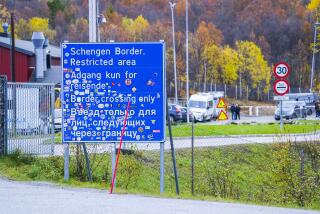Norway Plans Bridge Based on a Sketch by Da Vinci
- Share via
OSLO, Norway — The Norwegian highway department has found a bridge designer with unbeatably impressive credentials: Leonardo da Vinci, the original Renaissance Man.
The department aims to build a bridge that da Vinci designed nearly five centuries ago for a Turkish sultan, who rejected the plan in the belief that it wouldn’t work.
“This is the opposite of our usual projects,” said Haakon Haaversen, of the Norwegian highway department’s Akershus County office. “Usually we have a place that needs a bridge, and we design one to fit it. But now we have a bridge design and had to search for a place that suits it.”
Leonardo designed the bridge in 1502 to cross the Golden Horn inlet in Istanbul. With a length of 1,155 feet, it would have been the world’s longest bridge, and Sultan Bajazet II didn’t believe it could be completed.
The highway department is planning a modest 190-foot version of the bridge in Aas Township, about 1,500 miles north of the location Leonardo had in mind. The department wants to replace an ugly pedestrian bridge across a main highway.
The current structure, basically a slab on stilts, “is a pretty good example of how not to design a bridge,” said Knut Gloersen, head of highway planning for Akershus County.
Leonardo’s design, on the other hand, pleases aesthetes as much as engineers. The sketches show a graceful elliptical arch supporting a roadway that curves like an archer’s bow.
Vebjoern Sand, a Norwegian artist, saw a model of the bridge at an exhibition in Stockholm, and decided it had to be built. In 1995, he contacted Norwegian highway authorities and political leaders and gained broad support.
“The first time I saw the model it really excited me. It was so beautiful,” Sand said. He described it as “the primordial bridge, the perfect blend of art and function.”
“This is a bridge that has never been built but has been an inspiration to modern bridge designers,” he said. “It is the Mona Lisa, the queen of bridges. To build Leonardo’s bridge is to realize both history and art.”
The highway department is studying two proposals for the bridge--a wooden version, costing about $466,000, and one of stone, costing nearly three times as much.
“The wooden bridge would be a design inspired by da Vinci, while the stone one would be more of a monument,” Gloersen said. The highway department, at best, can fund a wooden bridge, but Sand said he was sure of raising the additional money for a stone bridge from other sources.
A final decision is due in November.
In a letter discovered in 1952, Leonardo offered to lead construction of the original bridge for the sultan, since no one else could be found. That led researchers to ask whether the sultan’s refusal had spared Leonardo a humiliating failure, or if he could have succeeded.
“‘While he had to rely on intuition for his designs, we used modern techniques and computers to test the design,” Gloersen said. “We can confirm that [Leonardo] was right. At least for the scale we’re working on.”
(BEGIN TEXT OF INFOBOX / INFOGRAPHIC)
Leonardo’s Bridge
The Norwegian highway department is building the bridge originally designed by Leonardo de Vinci in 1502 to cross the Golden Horn inlet in Istanbul. This scaled-down version will replace an existing pedestrian bridge in AAs Township, Norway.
More to Read
The biggest entertainment stories
Get our big stories about Hollywood, film, television, music, arts, culture and more right in your inbox as soon as they publish.
You may occasionally receive promotional content from the Los Angeles Times.










